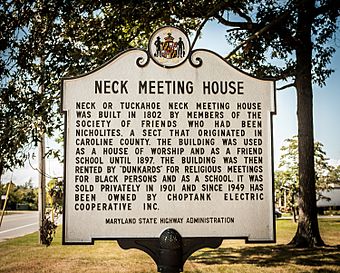Neck Meetinghouse and Yard facts for kids
Quick facts for kids |
|
|
Neck Meetinghouse and Yard
|
|
 |
|
| Location | MD 404, West Denton, Maryland, U.S. |
|---|---|
| Area | 1.5 acres (0.61 ha) |
| Built | 1802 |
| NRHP reference No. | 76000982 |
| Added to NRHP | October 22, 1976 |
The Neck Meetinghouse and Yard, also known as the Quaker Meetinghouse and Graveyard, is a very old building in West Denton, Maryland. It's a special place where Quakers used to meet. Quakers are a Christian group known for their peaceful beliefs.
This meetinghouse is a one-story building with a pointed roof. It is about 30 feet long and 20 feet deep. Next to the building is a graveyard. Here, you can find six marked graves from the 1850s to the 1890s, plus some newer ones.
The Neck Meetinghouse is the only Quaker meetinghouse still standing in Caroline County. It's also one of the few left on Maryland's Eastern Shore. The first meeting in this building was held on September 26, 1802. It was used until 1890, when it closed because there weren't enough people or money to keep it going.
In 1976, this historic building was added to the National Register of Historic Places. This means it's recognized as an important part of history.
Bringing the Meetinghouse Back to Life
After the Quakers stopped using the meetinghouse, the building began to fall apart. Many Quakers had moved away or joined other groups.
In 1930, some former members tried to fix it up a little. But soon, it was left to decay again. By 2002, the building was in really bad shape. Termites, tiny insects that eat wood, had caused a lot of damage.
Major Repairs Begin
Over the next two years, from 2002 to 2004, a lot of work was done to save the meetinghouse. Workers put in new foundations and brick supports. They replaced wooden parts damaged by termites, like the sills and floor beams. A brand new shingle roof was also added.
More Help Needed
Even after these big repairs, the building didn't get regular care. By 2017, it needed more fixes. The east side of the building was in the worst condition. This part was repaired by the summer of 2019.
However, there was no plan to fix the other three sides. There was also no plan for how to take care of the building all the time. So, a few people decided to step forward. They started a plan to raise money to restore the building. They also want to create a special fund to make sure the meetinghouse is always cared for in the future.



